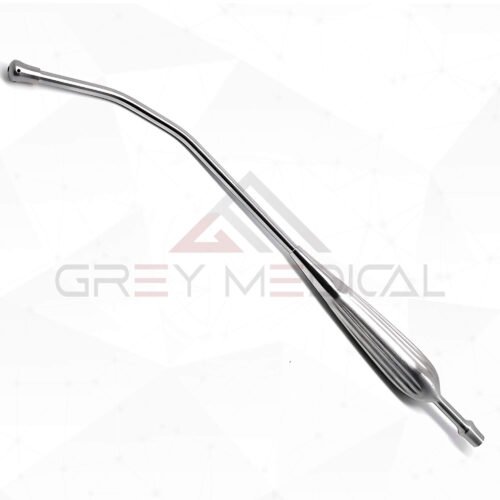Yankauer Suction Tube: A Versatile Tool for Fluid Management in Surgery
Yankauer Suction Tube: A Versatile Tool for Fluid Management in Surgery
Blog Article
The Yankauer suction tube is one of the most commonly used surgical instruments for fluid management in medical procedures. Known for its efficiency and precision, the Yankauer suction tube is used to remove blood, secretions, and other fluids from the surgical field, ensuring clear visibility for surgeons. Its unique design and versatility have made it a staple in operating rooms, emergency departments, and other healthcare settings. This blog explores the design, applications, and significance of the Yankauer suction tube in modern medicine.

What Is a Yankauer Suction Tube?
The Yankauer suction tube is a rigid, hollow instrument with a bulbous, slightly curved tip designed for precise suctioning. It is typically made from durable plastic or stainless steel and is connected to a vacuum source via flexible tubing. The instrument is ergonomically designed to allow for easy handling and control during procedures, making it a reliable tool for removing fluids without damaging surrounding tissues.
One of the defining features of the Yankauer suction tube is its rounded, open tip, which minimizes trauma to delicate tissues while ensuring effective suction. The tip may also have multiple small holes to prevent blockages and enhance its functionality. Some Yankauer suction tubes are vented, allowing the user to control the suction force by covering or uncovering a small hole on the handle.
Applications of the Yankauer Suction Tube
The Yankauer suction tube is widely used across various medical disciplines, reflecting its versatility and effectiveness. Below are some of its primary applications:
- Surgical Procedures
In surgeries, the Yankauer suction tube is indispensable for clearing blood, fluids, and debris from the operative field. By maintaining a clear view, it allows surgeons to perform procedures with greater precision. It is especially useful in thoracic, abdominal, and cardiovascular surgeries where significant fluid accumulation can obstruct visibility. - Airway Management
The Yankauer suction tube is frequently used in emergency and critical care settings for airway management. It helps remove secretions, vomit, or blood from the upper airway, reducing the risk of aspiration and ensuring a clear airway for intubation or ventilation. - Postoperative Care
After surgery, the Yankauer suction tube is used to clear residual blood or fluids from surgical drains or wound sites. Its gentle yet effective suctioning capabilities make it suitable for delicate postoperative cleaning. - Dental and Oral Surgery
In dental procedures and oral surgeries, the Yankauer suction tube is used to remove saliva, blood, and irrigation fluids from the oral cavity. Its precision and atraumatic design make it an ideal tool for working in confined spaces. - Palliative Care
For patients with advanced illnesses, the Yankauer suction tube is used to manage excessive oral secretions, providing comfort and improving quality of life.
Features of the Yankauer Suction Tube
The Yankauer suction tube’s design is tailored to meet the demands of fluid management in various medical settings. Key features include:
- Bulbous Tip: The rounded tip prevents damage to tissues and minimizes the risk of trauma, making it safe for use in delicate areas like the airway or surgical sites.
- Durable Construction: Made from high-quality plastic or stainless steel, the suction tube is resistant to wear and can withstand repeated sterilization or single-use applications in disposable versions.
- Vented and Non-Vented Options: Vented models allow for adjustable suction control, providing greater flexibility in managing fluid removal.
- Ergonomic Handle: The handle is designed for ease of use, ensuring a secure grip and precise maneuverability during procedures.
Importance of the Yankauer Suction Tube
The Yankauer suction tube plays a critical role in maintaining a clean and clear surgical field, which is essential for the success of any medical procedure. By effectively removing fluids and debris, it enhances visibility for the surgical team, reducing the risk of complications and improving patient outcomes.
In airway management, the Yankauer suction tube is vital for preventing aspiration, which can lead to life-threatening complications such as aspiration pneumonia. Its ability to quickly and efficiently clear the airway makes it a lifesaving tool in emergency situations.
The instrument’s versatility and atraumatic design also make it suitable for use in a wide range of medical applications, from surgeries to postoperative care and palliative settings. Its gentle suctioning capabilities ensure patient comfort while achieving the desired results.
Advancements in Yankauer Suction Tube Design
Modern advancements have further improved the functionality of the Yankauer suction tube. For instance, some models now incorporate antimicrobial properties to reduce the risk of infection during use. Others feature flexible or angled designs to enhance access to hard-to-reach areas.
Disposable Yankauer suction tubes are now widely available, offering a cost-effective and sterile solution for single-use applications. These advancements have made the instrument even more effective and accessible, ensuring it remains a cornerstone of fluid management in healthcare.
Conclusion
The Yankauer suction tube is a simple yet indispensable instrument in modern medicine. Its versatility, precision, and atraumatic design make it a vital tool for maintaining a clear surgical field, managing airways, and providing effective fluid removal in various medical settings.
Whether in the operating room, emergency department, or palliative care environment, the Yankauer suction tube exemplifies the importance of well-designed surgical instruments in delivering quality patient care. As medical technology continues to advance, this reliable tool will undoubtedly remain a critical component of fluid management, ensuring better outcomes for patients worldwide. Report this page